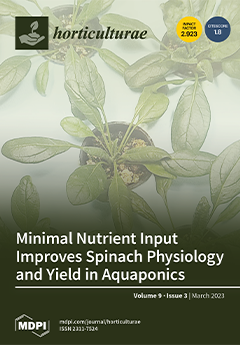(1) Background: The sweet orange (
Citrus sinensis) is the most widely cultivated and productive citrus fruit in the world, with considerable economic value and good prospects for development. However, post-harvest storage and transport of the fruit are often affected by infestation by
Penicillium species, leading to many losses. (2) Methods: In this study, the family of
bZIP genes from the whole genome of sweet orange was identified and analyzed in detail in terms of gene structure, physicochemical properties, protein structure, conserved structural domains, chromosomal positioning, and promoter analysis using bioinformatic analysis, in addition to an analysis of the expression patterns of the fruit following
Penicillium infection. (3) Results: In this study, 50
CsbZIP genes were identified from the sweet orange genome. In silico analysis showed that
Cs_ont_3g005140 was presumably localized in the chloroplasts, while the rest of the family members were located in the nucleus. Phylogenetic trees of grape, apple,
Arabidopsis, and sweet orange were constructed on the basis of evolutionary relationships and divided into 16 subfamilies. Conserved motif analysis showed that all
CsbZIP family genes encode proteins containing the highly conserved Motif 1. Promoter prediction analysis showed the chromosomal positioning, and the covariance analysis showed that the 50
CsbZIPs were unevenly distributed on nine chromosomes, with 10 pairs of duplicated genes. In the analysis of expression patterns, 11 of the 50
CsbZIP genes were not expressed, 12 were upregulated, 27 were downregulated, and five of the upregulated genes were highly expressed. (4) Conclusions: In this study, two
CsbZIP members were each closely related to two
Arabidopsis thaliana genes associated with salt stress. The functions of the replicated and re-differentiated
CsbZIP homologs (
Cs_ont_1g027160 and
Cs_ont_8g020880) divergee further, with one responding to inoculation by
Penicillium and the other not doing so. Five genes associated with sweet orange in response to
Penicillium infestation were initially screened (
Cs_ont_3g000400,
Cs_ont_3g003210,
Cs_ont_5g007090,
Cs_ont_5g011180,
Cs_ont_8g020880). This study provides some theoretical basis for subsequent research into the response mechanism of sweet orange
bZIP transcription factors under biotic stresses.
Full article





